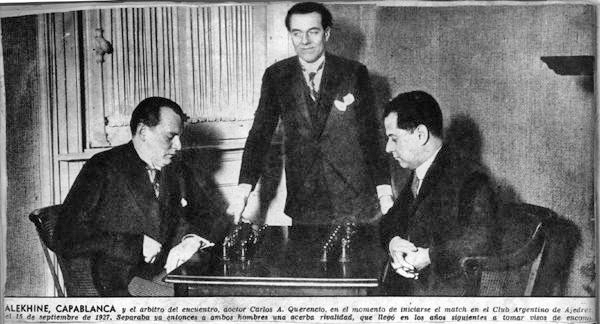“I should be grateful if you would consider the present letter as an official challenge to a match for the World Chess Championship.” Excerpt from a letter from Alexander Alekhine to Raul Capablanca.
e6. Alexander Alekhine’s first move in the first game against the famous Chess Champion Raul Capablanca from Cuba. This move was in reply to the most common opening move in chess, e4. This opening sequence begins what is known as the French Defense. It was fitting that this would be the first move by Alekhine, seeing as he would be finally granted French citizenship during this match. This match was played in Buenos Aires, Argentina, in 1927. How did this match for the World Chess Championship end up in Argentina between a Cuban player and an anti-Bolshevik dissident from Russia?
The answer lies in the sheer determination and hunger to win exhibited by Alekhine, and there are many lessons to consider as we follow his quest to become the World Chess Champion. However, let me first describe whom Alekhine was seeking to defeat. José Raúl Capablanca was arguably one of the best naturally gifted chess players who have ever lived. He was a child prodigy, beating the Cuban champion when he was only 12. He quickly went on to defeat many of the famous names in chess, including many of the popular Russian players. At 23 years old, he was invited to the 1911 San Sebastián tournament, where he defeated Rubinstein, Nimzowitsch, and Tarrasch, all of whom had become the most famous chess players in the world. From 1916 to 1924, through quite active play, he went on to be undefeated during that time and, in the process, defeated Emanuel Lasker in 1921 for the World Chess Championship. Prior to the 1927 match in Argentina, Alekhine had played against Capablanca several times, which either resulted in draws or losses. Alekhine had never beaten Capablanca prior to the 1927 Championship match. Also, just a few months prior to this match with Alekhine, Capablanca had just dominated the best chess players in the 1927 New York chess tournament.
Needless to say, Capablanca was highly favored for this match. The assumption was that this was more of an exhibition than a serious contention for the Chess title. Capablanca would not agree to play against an opponent unless the challenger could raise $10K for the prize fund, of which the Champion would retain half even if losing. Also, if the match concluded in a tie, the Champion would retain the title. So, the only way a player like Alekhine could vie for the Championship was if he could raise $10K and would have to win outright. This was almost insurmountable at the time, and a few other contenders also struggled to raise the required purse. However, dogged determination and pushing forward to the endgame was Alekhine’s specialty. He would get his chance, so let’s take a look at the journey that got him there.
Alekhine was born 4 years after Capablanca in 1892 in Moscow, Russia. He was from a wealthy Russian family. Being in and around Russian aristocracy got him, his brother, and sister involved in the game of chess. He first showed signs of brilliance when he won the Moscow Chess Club spring tournament in 1908 at the age of 15. Now, keep in mind, average chess players in Russia at the time were better than most of the world’s chess population, so winning a small tournament, especially in Moscow, was a big deal. He went on to St. Petersburg to study law and started to work up the ranks in the local chess community. He ended up tying with the famous Aron Nimzowitsch in a major Russian match in 1914. Later that year, ironically, he placed 3rd next to Emanuel Lasker and José Raúl Capablanca, the two World Chess Champions who would precede him.
He was probably ready for the international chess stage at this point, but he attended an invitation chess tournament in Mannheim, Germany. During the match (which he was dominating), World War I broke out. He and his Russian companions were all arrested and held in custody. He eventually was released and got back to Russia. He started to play exhibition matches to raise money to help bail out more of his Russian chess player friends in Germany.
He started visiting various locations, including hospitals on the war front. He played these simultaneous exhibitions, where he played a bunch of chess players at once wearing a blindfold. He amazed and entertained, all the while winning small tournaments to raise money. When the Russian army defeated the Germans in Ukraine, he was arrested and thrown in jail over suspicions of being anti-communist. Chess players in the West all thought he had been killed by Bolshevik revolutionaries.
This all settled down, and he started to win most matches and tournaments in Russia. After his first failed marriage, he met a Swiss journalist and got married. He convinced the Russian government to let him go to Paris with his new wife and, upon leaving Russia, never went back. He applied for French citizenship, which took a long time to secure. His goal was to challenge Capablanca, but that required him to raise money. He embarked on a massive tour to raise funds for this purpose, holding world record-breaking blindfold simultaneous exhibitions against other chess players. In 1924 in New York, he played against 26 chess players with a record of 16-5-5. Then, in Paris, he played 28 players with a record of 22-3-3. However, he could not raise the requisite funds. Eventually, he convinced some businessmen from Argentina to put up the funds for the match, and that is how he finally got his World Championship Match. That is how the games ended up being hosted in Buenos Aires.
If you are not a chess player, then you probably do not know the outcome of this 1927 match between Capablanca and Alekhine. Well, the first game was a shock to the chess world and a shock to Capablanca. He lost against the French Defense in that first game. Alekhine was up 1-0 in a race to see who could get to 6 wins. Alekhine had won with the black pieces, which is always considered harder to do at this level of chess. The tournament rules indicated that the first player to win 6 games would be declared Champion. If the score ever reached 5-5, then the tournament would be declared a draw, and the Champion would retain the title. Capablanca must have realized that this was not going to be easy. In fact, he never opened with e4 again during the entire tournament. From then on, he would only play d4, adopting traditional Queen’s Gambit openings.
Capablanca evened up the score at 1-1 during the third game, winning decisively with the white pieces. He then went ahead 2-1 in the 7th game. It seemed that Capablanca was returning to his usual dominating chess play. However, the two kept playing the same opening sequence, Queen’s Gambit Declined, and Alekhine proved his preparation for this match superior by winning with the black pieces again in the 11th game. The match was now tied at 2-2. Capablanca must have been devastated when, in the 12th game, Alekhine won with the white pieces, once again with the Queen’s Gambit Declined. Capablanca was famous for his endgame capabilities, having an uncanny sense of how the game would unfold based on exchanges and piece movement in the middle of the game. However, it was clear after the match score reached 3-2 that Alekhine’s endgame play was superior.
Now, this was serious. Alekhine sensed a potential win, and I could imagine Capablanca wiping his typical grin off his face as they both locked horns in an intense battle. For the next 8 games, they drew each game, resulting in no change in the match score. Then, in the 21st game, Alekhine delivered the ultimate gut punch with another win with the black pieces, winning another Queen’s Gambit opening in decisive fashion. Alekhine was now up 4-2.
However, Capablanca was called one of the best chess players ever for a reason. They battled through 7 more draws, and in the 29th game, Capablanca defeated Alekhine in a 70-move game. Alekhine just fell apart. Capablanca played with precision and dominated the endgame with superior pawn positioning. Now the tournament score was 4-3. However, based on this last game, many thought that Alekhine was showing signs of crumbling. Capablanca had missed a few opportunities to win a couple of the drawn games. Game 31 was the same. Capablanca had a clear advantage in the end but failed to capitalize. The game ended in a draw.
This is when something just flipped. Alekhine suddenly shifted into teaching mode. He essentially taught the entire chess world how to win an endgame in a clear, decisive manner. He delivered two more games that are constantly used in chess books to teach people “how to play an endgame scenario.” He won game 32 and then game 34. Alekhine won the Chess Championship 6-3.
Alexander Alekhine’s arduous journey to becoming the World Chess Champion is a tale replete with invaluable lessons, not just for aspiring chess grandmasters but for anyone pursuing excellence in their field.
First and foremost, Alekhine’s journey underscores the importance of sheer determination and resilience. Despite numerous setbacks, including political upheaval, imprisonment, and financial challenges, Alekhine’s unwavering commitment to his goal never faltered. His ability to persevere in the face of adversity is a testament to the power of a steadfast spirit and a focused mind.
Alekhine’s strategic brilliance and innovative approach to the game remind us of the importance of continuous learning and adaptation. His meticulous study of his opponent’s games, deep understanding of chess strategies, and the introduction of novel ideas in his gameplays, such as his profound preparation for the Queen’s Gambit Declined, show the value of thorough preparation and the courage to innovate.
Moreover, Alekhine’s journey highlights the significance of mental fortitude and psychological readiness. Chess, much like life, is as much a mental battle as it is a battle of skills. Alekhine’s ability to maintain composure and confidence, even when the odds were against him, and his capacity to capitalize on his opponent’s psychological weaknesses were crucial to his success.
Alekhine’s story also speaks to the importance of seizing opportunities and making the most of them. His relentless pursuit of the championship, including his efforts to secure funding and the strategic use of his blindfold simultaneous exhibitions, illustrates the importance of resourcefulness and the ability to turn challenges into stepping stones.
Finally, Alekhine’s legacy teaches us that success is not just about achieving one’s goal but also about leaving a mark and contributing to the broader community. His innovations and strategic contributions to the game of chess have enriched the chess world and continue to inspire chess enthusiasts worldwide.
In conclusion, Alekhine’s journey to clinching the World Chess Champion title is a rich narrative of resilience, strategic brilliance, mental fortitude, resourcefulness, and legacy. His story is a powerful reminder that the path to greatness is often laden with challenges, but with perseverance, innovation, and strength of character, triumph is within reach.




